General approach to pest, disease and weed management
The organic approach to plant pest, plant disease and weed management makes reference to the four principles of organic agriculture: the principle of health, the principle of ecology, the principle of fairness, and the principle of care (see IFOAM principles of organic agriculture in the introduction to organic agriculture chapter). Generally, organic farmers aim at sustaining and enhancing the health of their soils, plants, animals, humankind and—in the widest sense—the planet. The health of individuals and communities cannot be separated from the health of ecosystems. Therefore, by providing healthy soils and a diversified natural environment, farmers are able to produce healthy crops that foster the health of animals and people.
Healthy plants are also able to resist and tolerate physiological disruption and damage from disease-causing organisms and pests. Thus, organic farmers aim at optimizing the growing conditions for their crops to make them strong and competitive. At the same time, they encourage natural control mechanisms to prevent pests, diseases and weeds to develop in a way that they cannot damage the crops. They, therefore, give priority to preventive measures to prevent and limit the spread of infections, instead of relying on direct control measures. Direct control measures are mainly applied when pathogens have already developed.
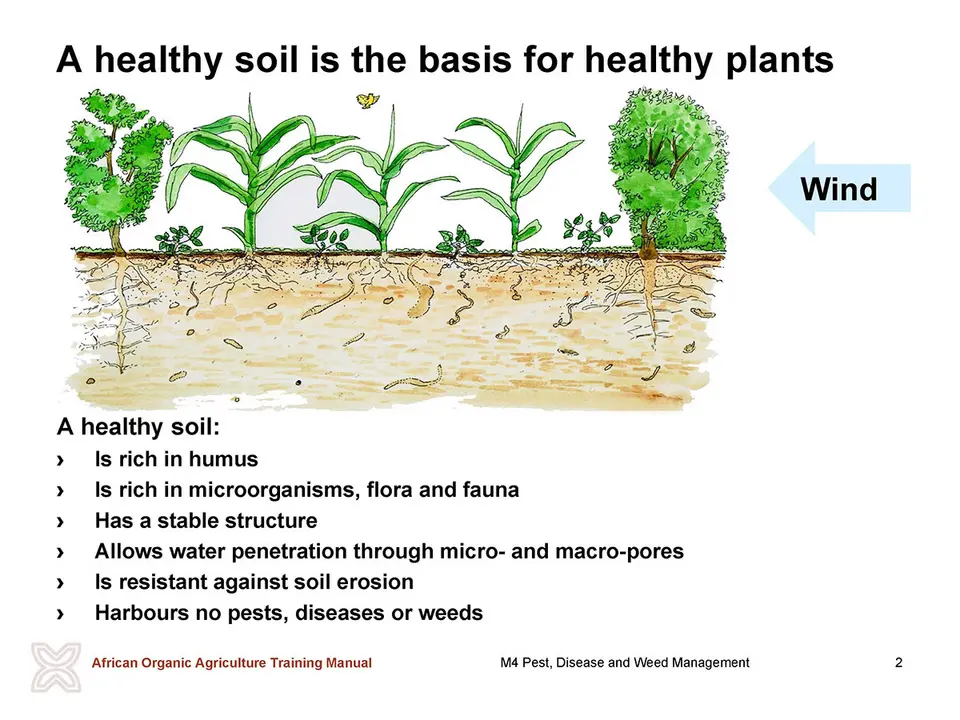
Organic plant pest, plant disease and weed management is based on:
- Enhancement of a healthy, fertile soil and good growing conditions to promote healthy plants.
- Growing suitable varieties that are adapted to the local conditions and resistant to major pests and diseases.
- Proper monitoring of pests and diseases in order to encourage timely and effective intervention.
- Non-reliance on externally sourced and costly inputs.
- Minimizing the spread and multiplication of pests, diseases and weeds and thus reducing losses in the field and during storage.
- Enhancement of natural predators to encourage natural control mechanisms.
- Direct control tools that respect and protect the natural resources soil, water, air, and biodiversity. Negative impact on the environment is also avoided by not using synthetic fertilisers and pesticides.
The three-step approach
Organic pest, disease and weed management can be seen as a three-step approach with multiple tools.
- Step 1: The first step consists of providing good growing conditions for plants to enhance their resilience and resistance.
- Step 2: The second step consists of encouraging natural control mechanisms through promotion of natural enemies.
- Step 3: The third step involves application of direct control measures to kill the pests, diseases or weeds in a way that has minimum residual effect to the ecosystem.
For a comparison, the three-step approach also applies to human health care management:
- 1st step measures: Provision of sufficient and healthy food and water and the preservation of a healthy environment to encourage human health. It also includes good behavioural practices to avoid illness by simple measures of hygiene (e.g. washing hands regularly and brushing teeth) and appropriate exercise to strengthen the body.
- 2nd step measures: Preventative intake of vitamins, antioxidants or probiotic agents and the use of natural medicine against illness (e.g. traditional medicine, medical herbs and homeopathy).
- 3rd step measures: Direct treatment using antibiotics and other medicines to kill off infections.
Each step of the three-step approach builds the foundation for the next step. The aim is to optimize steps 1 and 2 in order to encourage natural self-control of pathogens and to minimize the direct control measures (step 3). With proper and efficient application of steps 1 and 2, direct intervention is usually not needed. This saves on costs and prevents negative impacts of some direct control tools on the farm ecosystem.
Decades of practical experience from organic farmers and results of scientific research on organic pest, disease and weed management in the last 30 years have shown that the combination of indirect and direct control measures is more effective. As knowledge of the interaction of pest and disease pathogens and their natural enemies increases further, efficiency of this holistic approach also increases. Ideally, farmers will eventually be able to renounce any direct control measures and instead maximize the use of natural processes.
Discussion comparing human health with plant health
Invite the farmers to identify the similarities and differences between human health and plant health care. The functioning of plant health care can be elaborated on in groups and discussed in a plenary session.
Plant pest and disease management
Organic methods can be very effective in the management of pests and disease, especially if applied well and on time. However, with certain devastative pest or disease outbreaks, more aggressive conventional means may be required in order to limit the spread of infections. In some cases, it may be a national regulatory requirement for all farmers to comply and thus individual farmers may have little or no control. Organic agriculture recognizes such situations and farmers should inform consumers or their certification bodies in order to find alternative remedial actions.
Steps and tools to pest and disease management - The organic pest and disease management toolbox
1st step: Crop management practices
These practices aim at providing good growing conditions to enhance plant health and prevention of introduction and spread of pests and diseases. This can be achieved through the following practices:
- Choice of appropriate crop varieties suitable for the location. Where possible, varieties tolerant or resistant to pests and diseases should be used.
- Using clean planting materials.
- Soil fertility improvement to encourage strong and vigorous growing plants, by using compost, animal manure, green manure and other organic materials.
- Intercropping and crop rotation to reduce the multiplication rate of pests.
- Other good management practices to ensure proper growth (e.g. timely planting, proper spacing, water conservation, pruning, shade management and timely harvesting).
2nd step: Habitat management practices
These practices aim at enhancing the proliferation of a variety of organisms (including natural enemies) around and within the crop fields. These include:
- Planting hedges of indigenous plant species around fields to attract natural enemies. Allowing flowering plant species to grow within crops to provide nectar and pollen for natural enemies like ladybird beetles, hoverflies and parasitoids.
- Trap cropping to attract pests to non-crops or push away pests from the crops (e.g. push-pull strategy).
- Field hygiene, including timely weeding to remove alternative hosts, roguing infected plants and plant parts, proper disposal of infected plants and disinfecting tools used on infected plants/fields.
3rd step: Direct control
In situations of heavy infestations or very devastative pests and diseases, direct measures will be needed to minimize losses. These tools will only be fully effective when tools in the other two steps are applied properly.
These include:
- Biological control agents such as predatory insects and mites, insect parasitoids, viruses and bacteria.
- Approved or self-made insecticides or acaricides (against mites) of biological or mineral origin including plant extracts, plant oils, mineral oil, copper and sulphur.
- If available, insect pheromone traps may be used to disrupt mating of pests.
- Light, bait or colour traps may be used for mass-trapping pests.
- Hot water treatments of seeds to limit seed-borne diseases.
Weed management
A weed is a plant growing in a place where it is not wanted by humans. In agriculture, weeds may damage crops when growing in fields or poison domesticated animals when growing on pasture land. They can roughly be grouped into annual and perennial plant species.
Annual weeds are plants that normally take advantage of temporarily bare soil to produce another generation of seeds before the soil is covered again by crops.
Perennial weeds are plants that grow for many seasons. They propagate either by seeds or by the spread of vegetative parts, such as roots or tubers. Regeneration by vegetative means is a unique characteristic to perennial weeds, meaning even the smallest root or stem can reproduce an entire plant.
Steps and tools to weed management - The organic weed management toolbox
1st step: Crop management practices
These practices aim at limiting the introduction and multiplication of weeds. These include:
- Use of crop seeds free of weed seeds.
- Appropriate land preparation, adapted to either annual or perennial weeds. Perennial weeds should be removed as much as possible before planting or covered with an aggressive green manure plant, otherwise they are difficult to control after planting the main crop.
2nd step: Habitat management
These practices aim at reducing the impact of weeds on the growing plants:
- Intercropping or cover cropping to rapidly cover the soil before weeds emerge.
- Mulching to suppress weed growth.
3rd step: Direct control
On top of the practices in the 2nd step, direct control practices may be applied to completely eliminate the weeds. These practices include:
- Mechanical control by hand, animal traction or appropriate machines to remove weeds.
- Use of biological control agents, meaning the use of specific plant diseases or plant pests against weeds.
- Thermal weed control (flame weeding).
Monitoring of pests, diseases and weeds
Study the pests, diseases and weeds
Regular monitoring of pests, diseases and weeds is the basis for effective management. To be able to manage pests, diseases and weeds, information is needed on the specific pests, diseases and weeds present in the region, village or crop fields and the associated damage they cause.
Typical signs of pest attacks on crop plants
Most crop pests belong to the insects, mites and nematodes. However, in Africa, mammals (like elephants, monkeys or voles), and birds (like sparrows, starlings and crows) can also damage crops. Pest damage is obvious and easy to identify.
Insect damage can be categorized by biting and chewing (e.g. caterpillars, weevils), piercing and sucking (e.g. aphids, psyllids) and boring (e.g. borer, leaf miner) species. Some are slow moving (e.g. caterpillars), fast moving (e.g. fruit flies), hidden (e.g. stem borer), or easy to observe (e.g. caterpillars, weevils).
Pest damage is often species-specific: leaves with holes or missing parts is an indication of caterpillar or weevil damage; curled leaves is an indication of aphids; damaged or rotten fruits are often caused by larvae of fruit flies; withering plants can also be caused by larvae of noctuids or the stem borer; and branches or trunks with holes may be an attack by lignivorous insects.
Mites are very small and cannot be seen with the naked eye. However, some mite species (spider mites) weave a typical tissue on attacked plant parts and can, therefore, easily be detected. If mites are present on plants, leaves and fruits become yellowish.
Nematodes are also very small and therefore, they are not easy to observe with the naked eye. They mostly attack plant roots; plants become yellow, wither and die.
Typical signs of disease attacks on crop plants
Most crop diseases are caused by fungi, bacteria or viruses.
Fungi cause the great majority, estimated at two-thirds, of infectious plant diseases. They include all white and true rusts, smuts, needle casts, leaf curls, mildew, sooty moulds and anthracnose. In addition, they are responsible for most leaf, fruit, and flower spots, cankers, blights, wilts, scabs, and root, stem, fruit, wood rots among many others. Parts of plants or the total crop plant can wither and die.
Bacteria cause any of the four following main problems. Some bacteria produce enzymes that breakdown the cell walls of plants anywhere in the plant. This causes parts of the plant to start rotting (known as ‘rot’). Some bacteria produce toxins that are generally damaging to plant tissues, usually causing early death of the plant. Others produce large amounts of very sticky sugars; as they travel through the plant, they block the narrow channels preventing water getting from the plant roots up to the shoots and leaves, again causing rapid death of the plant. Finally, other bacteria produce proteins that mimic plant hormones. These lead to overgrowth of plant tissue and form tumours.
Viruses mostly cause systemic diseases. Generally, leaves show chlorosis or change in colour of leaves and other green parts. Light green or yellow patches of various shades, shapes and sizes appear in affected leaves. These patches may form characteristic mosaic patterns, resulting in general reduction in growth and vigour of the plant.
Before managing any particular pests, diseases and weeds, the farmer should know how it behaves in relation to the concerned crop.
Guiding criteria for understanding pests, diseases and weeds
Pests
- At what stage of the lifecycle is it a pest: larvae, caterpillar or adult?
- At what stage of plant growth does it attack: seedling, growing or mature plant?
- Which part of the plant does it attack: leaves, roots, stem, fruits, seeds or the entire plant?
- What kind of damage does it cause: chewing, sucking or the death of the plant?
- When does it attack: dry season or wet season?
Diseases
- What is the cause of the disease: virus, bacteria or fungus?
- How is the disease transmitted: by seeds, through the soil, by air or by insects?
- At what stage of plant growth does it attack: seedling, growing or mature plant?
- Which plant part is attacked: leaves, roots, stem, fruits, seeds or the entire plant?
- What kind of damage does it cause: rotting, chlorosis, wilting, spots, etc.?
- When does it attack: in the dry season or the wet season?
Weeds
- Is the weed perennial or annual?
- How is it spread: by seeds, rhizomes, etc.?
- Which conditions promote its growth?
Field visit or exercise to identify pest and disease causing organisms
Collect plant samples showing different pest and disease damage, and invite the farmers to categorise the symptoms into fungal, bacterial or viral infections.
Field scouting for pests and diseases
Careful and continuous monitoring of pest and disease levels during critical times of growth of a crop is the key to successful management. This can be done through regular scouting of the field by the farmer. It helps the farmer to intervene early enough before the pest and/or disease cause significant damage. Scouting avoids unnecessary use of natural plant extracts. Limited use of these substances (e.g. pyrethrum, derris and tobacco) and oils is important as they also have negative effects on beneficial insects. If the application of these substances is not regulated, many pest predators and parasitoids may be killed as well. Over application of these substances may also lead to pests developing resistance.
Therefore, scouting should be planned and done in an organised way. It is important to get a random sample that will be representative of the overall situation in the crop garden. Therefore, the scout (farmer) needs to observe and record any of the findings for better decision making. The most common pattern in pest and disease scouting programs involves walking along a predetermined zigzag or M-shaped route through a field. This pattern is commonly used because it is easy to teach, convenient to use, and ensures that all regions of the field are visited.
To monitor insect pests, different traps can also be used. The simple idea is to know more about the presence of the insect pests in the field especially the fast moving (mobile) insect pests (e.g. fruit flies, lepidopteran pests).
- Fruit flies can be captured using bait traps. For example, PE-bottles with small holes can be half-filled with water, some cattle urine, fruit flesh or a small dead fish and a drop of detergent or soapy water. These bottles are then hung in trees and checked every three days.
- Yellow plastic cards coated with adhesive are also good for trapping aphids and leafhopper. Yellow-orange plastic boards are appropriate for white flies, while blue cards are appropriate for thrips monitoring.
- Light traps are especially needed where noctuids (e.g. moths, cutworms, African armyworm, and cotton bollworm) are a problem. Within crops attacked by cutworms, visual checks of caterpillars have to be done by dawn.
Group work for monitoring insect pests
Choose any crop fields in the neighbourhood for a trial scouting exercise for pests and disease infestations. Demonstrate how scouting is done, emphasizing the need to know what to look for and where to start looking.
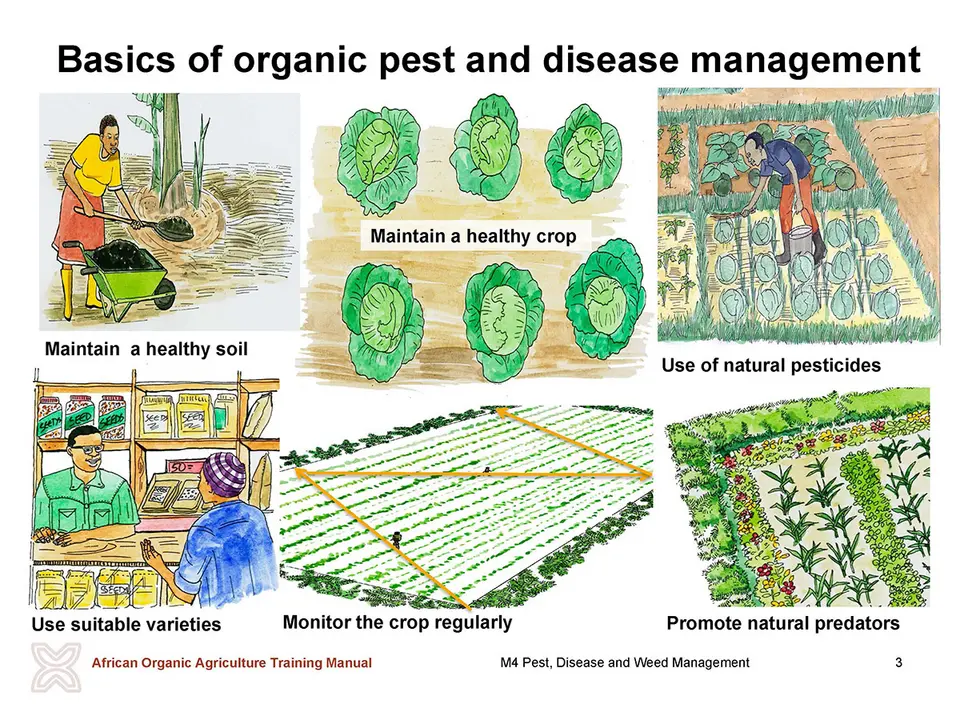
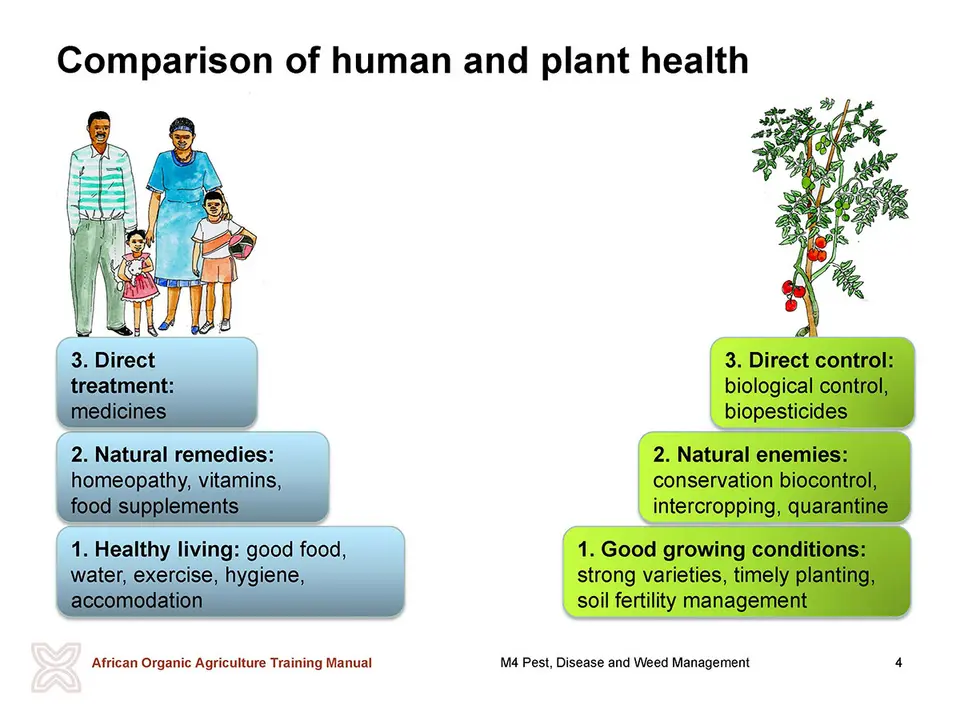
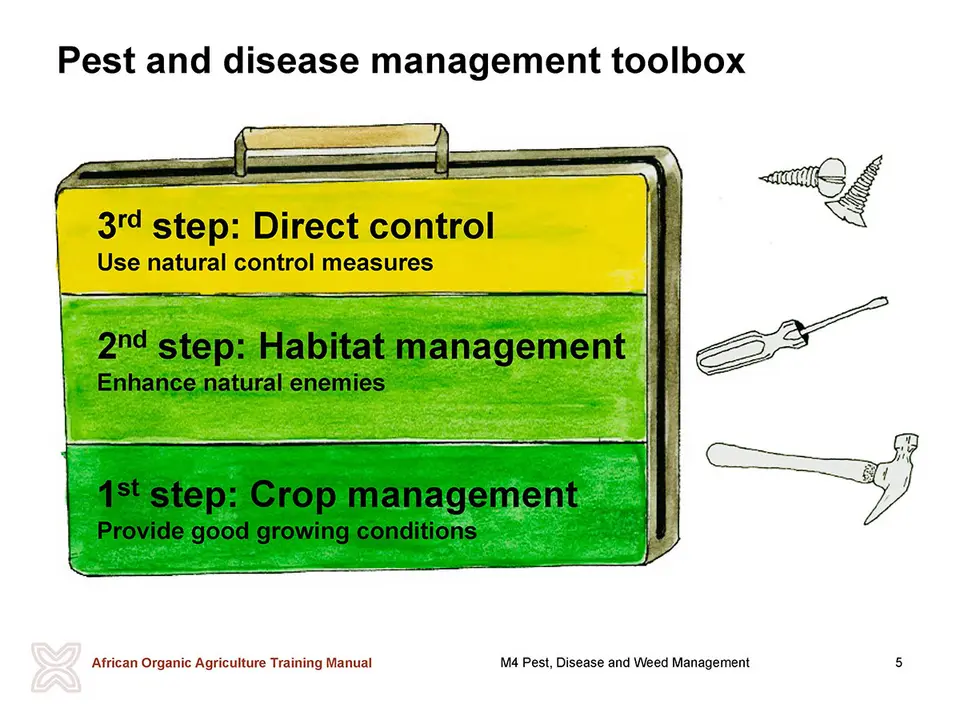

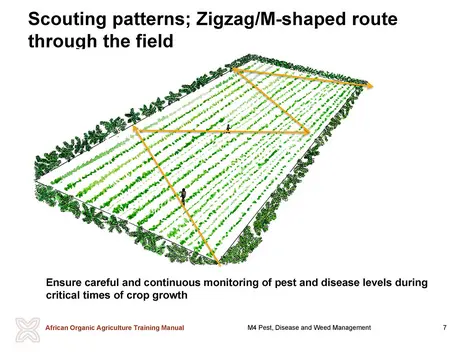
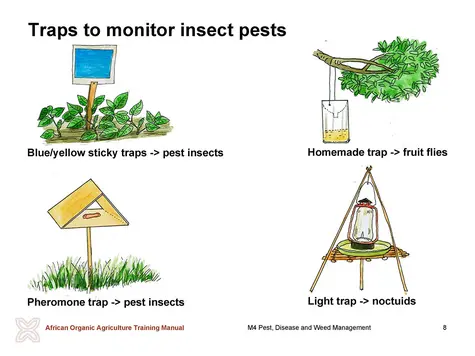
 tap and then scroll down to the Add to Home Screen command.
tap and then scroll down to the Add to Home Screen command.